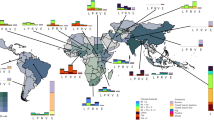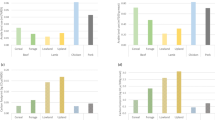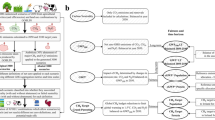Abstract
The production and consumption of livestock products are under examination on environmental, human health and animal welfare grounds. However, a wealth of evidence suggests that the livestock sector has complex interactions with the UN Sustainable Development Goals, with both the problem and solution spaces for livestock interventions varying depending on the context. To circumvent the uncertainty associated with incomplete or conflicting evidence for making policy recommendations, we suggest a sharper focus on local solutions to global targets, as well as due attention to cross-scale feedbacks that occur between them. Our analysis offers a lens that focuses on balancing both the costs and benefits of the livestock sector, and can be used to define better livestock policy that steers the planet towards a more sustainable and food-secure future.
This is a preview of subscription content, access via your institution
Access options
Access Nature and 54 other Nature Portfolio journals
Get Nature+, our best-value online-access subscription
$29.99 / 30 days
cancel any time
Subscribe to this journal
Receive 12 digital issues and online access to articles
$119.00 per year
only $9.92 per issue
Buy this article
- Purchase on Springer Link
- Instant access to full article PDF
Prices may be subject to local taxes which are calculated during checkout


Similar content being viewed by others
References
Foley, J. A. et al. Solutions for a cultivated planet. Nature 478, 337–342 (2011).
Tilman, D. & Clark, M. Global diets link environmental sustainability and human health. Nature 515, 518–522 (2014).
Newbold, T. et al. Has land use pushed terrestrial biodiversity beyond the planetary boundary? A global assessment. Science 353, 288–291 (2016).
Mekonnen, M. M. & Hoekstra, A. Y. The green, blue and grey water footprint of crops and derived crop products. Hydrol. Earth Syst. Sci. 15, 1577–1600 (2011).
Landrigan, P. J. et al. The Lancet Commission on pollution and health. Lancet 6736, 462–512 (2017).
Nilsson, M., Griggs, D. & Visback, M. Map the interactions between Sustainable Development Goals. Nature 534, 320–322 (2016).
Shepherd, K. D. et al. Development goals should enable decision-making. Nature 523, 152–154 (2015).
Bowen, K. J. et al. Implementing the “Sustainable Development Goals”: towards addressing three key governance challenges—collective action, trade-offs, and accountability. Curr. Opin. Environ. Sustain. 26–27, 90–96 (2017).
Obersteiner, M. et al. Assessing the land resource–food price nexus of the Sustainable Development Goals. Sci. Adv. 2, e1501499 (2016).
Poore, J. & Nemecek, T. Reducing food’s environmental impacts through producers and consumers. Science 992, 987–992 (2018).
Springmann, M., Godfray, H. C. J., Rayner, M. & Scarborough, P. Analysis and valuation of the health and climate change cobenefits of dietary change. Proc. Natl Acad. Sci. USA 113, 4146–4151 (2016).
Tilman, D. et al. Future threats to biodiversity and pathways to their prevention. Nature 546, 73–81 (2017).
Willett, W. et al. Food in the Anthropocene: the EAT-Lancet Commission on healthy diets from sustainable food systems. Lancet 6736, 447–492 (2019).
Pica-Ciamarra, U., Tasciotti, L., Otte, J. & Zezza, A. Livestock Assets, Livestock Income and Rural Households: Cross-Country Evidence from Household Surveys 18 (World Bank, 2011).
Frelat, R., Lopez-ridaura, S., Giller, K. E., Herrero, M. & Douxchamps, S. Drivers of household food availability in sub-Saharan Africa based on big data from small farms. Proc. Natl Acad. Sci. USA 113, 458–463 (2016).
Coughenour, M. B. et al. Energy extraction and use in a nomadic pastoral ecosystem. Science 230, 619–625 (1985).
Cordain, L., Eaton, S., Miller, J. B., Mann, N. & Hill, K. The paradoxical nature of hunter-gatherer diets: meat-based, yet non-atherogenic. Eur. J. Clin. Nutr. 56, 42–52 (2002).
Grace, D. et al. The Influence of Livestock-Derived Foods on Nutrition During the First 1,000 Days of Life Research Report No. 44 (ILRI, 2018).
The State of Food and Agriculture: Livestock in Balance (FAO, 2009); https://doi.org/10.1016/S0140-6736(75)92740-3
Smil, V. Eating meat. Popul. Dev. Rev. 28, 299–639 (2009).
Springmann, M. et al. Options for keeping the food system within environmental limits. Nature 562, 519–525 (2018).
Springmann, M., Godfray, H. C. J., Rayner, M. & Scarborough, P. Analysis and valuation of the health and climate change cobenefits of dietary change. Proc. Natl Acad. Sci. USA 113, 4146–4151 (2016).
FAOSTAT (FAO, 2020); http://www.fao.org/faostat/en/#home
2000 World Census of Agriculture (FAO, 2013).
Megersa, B., Markemann, A., Angassa, A. & Valle Zárate, A. The role of livestock diversification in ensuring household food security under a changing climate in Borana, Ethiopia. Food Secur. 6, 15–28 (2014).
Sloat, L. L. et al. The increasing importance of precipitation variability on global livestock grazing lands. Nat. Clim. Change 8, 214–218 (2018).
Hiernaux, P. & Ayantunde, A. The Fakara: A Semi-arid Agro-ecosystem Under Stress GEF/2711-02-4516 1–95 (ILRI, 2004).
The Contribution of Livestock to the Ethiopian Economy (IGAD, 2009).
Ashley, S., Holden, S. & Bazeley, P. Livestock in Development (OutHouse, 1999).
Alam, J. Impact of smallholder livestock development project in some selected areas of rural Bangladesh. Livest. Res. Rural Dev. 9, 25 (1997).
Fraval, S. Food Security in Rural Sub-Saharan Africa. A Household Level Assessment of Crop-Livestock Systems. PhD thesis, Wageningen Univ. (2019).
Murphy, S. P. et al. Animal source foods to improve micronutrient nutrition and human function in developing countries: school snacks containing animal source foods improve dietary quality for children in rural Kenya. J. Nutr. 133, 3950S–3956S (2003).
Herrero, M. et al. Greenhouse gas mitigation potentials in the livestock sector. Nat. Clim. Change 6, 452–461 (2016).
Ramankutty, N., Evan, A. T., Monfreda, C. & Foley, J. A. Farming the planet: 1. Geographic distribution of global agricultural lands in the year 2000. Glob. Biogeochem. Cycles 22, 1–19 (2008).
Cassidy, E. S., West, P. C., Gerber, J. S. & Foley, J. A. Redefining agricultural yields: from tonnes to people nourished per hectare. Environ. Res. Lett. 8, 034015 (2013).
Mekonnen, M. M. & Hoekstra, A. Y. A global assessment of the water footprint of farm animal products. Ecosystems 15, 401–415 (2012).
Hoekstra, A. Y. & Mekonnen, M. M. The water footprint of humanity. Proc. Natl Acad. Sci. USA 109, 3232–3237 (2012).
Newbold, T. et al. Global effects of land use on local terrestrial biodiversity. Nature 520, 45–50 (2015).
Mekonnen, M. M. & Hoekstra, A. Y. Four billion people facing severe water scarcity. Sci. Adv. 2, e1500323–e1500323 (2016).
Diffenbaugh, N. S. et al. Quantifying the influence of global warming on unprecedented extreme climate events. Proc. Natl Acad. Sci. USA 114, 201618082 (2017).
Van Boeckel, T. P. et al. Global trends in antimicrobial use in food animals. Proc. Natl Acad. Sci. USA 112, 5649–5654 (2015).
Laxminarayan, R. et al. Antibiotic resistance—the need for global solutions. Lancet Infect. Dis. 13, 1057–1098 (2013).
Littmann, J., Zorzet, A. & Cars, O. Antimicrobial resistance—a threat to the world’s sustainable development. Upsala J. Med. Sci. 121, 159–164 (2016).
Global Burden of Disease Collaborative Network Global Burden of Disease Study 2017 (GBD 2017) (Institute for Health Metrics and Evaluation, 2018).
International Livestock Research Institute. Mapping of poverty and likely zoonoses hotspots. Zoonoses Rep. 4, 1–119 (2012).
Jones, B. A. et al. Zoonosis emergence linked to agricultural intensification and environmental change. Proc. Natl Acad. Sci. USA 110, 8399–8404 (2013).
Allen, T. et al. Global hotspots and correlates of emerging zoonotic diseases. Nat. Commun. 8, 1124 (2017).
Global Nutrition Targets 2025: Stunting Policy Brief WHO/NMH/NHD/14.3 (WHO, 2014).
Brody, H. Poverty reduction through animal health. Nature 543, S41–S41 (2017).
Awokuse, T. O. & Xie, R. Does agriculture really matter for economic growth in developing countries? Can J. Agric. Econ. 63, 77–99 (2015).
Mora, C. et al. Global risk of deadly heat. Nat. Clim. Change 7, 501–506 (2017).
Curtis, P. G., Slay, C. M., Harris, N. L., Tyukavina, A. & Hansen, M. C. Classifying drivers of global forest loss. Science 361, 1108–1111 (2018).
Herrero, M. et al. Biomass use, production, feed efficiencies, and greenhouse gas emissions from global livestock systems. Proc. Natl Acad. Sci. USA 110, 20888–20893 (2013).
A European Union One Health Action Plan against Antimicrobial Resistance (AMR) (European Commission, 2017).
Clark, M. A., Springmann, M., Hill, J. & Tilman, D. Multiple health and environmental impacts of foods. Proc. Natl Acad. Sci. USA 116, 23357–23362 (2019).
Agriculture Value Added (%GDP) (World Bank, accessed 10 June 2017); http://data.worldbank.org/indicator/NV.AGR.TOTL.ZS
Herforth, A. et al. A global review of food-based dietary guidelines. Adv. Nutr. 10, 590–605 (2019).
Stokstad, P. Enforcing environmental law in an unequal market: the case of concentrated animal feeding operations. Missouri Environ. Law Policy Rev. 15, 229–272 (2008).
Clay, N., Garnett, T. & Lorimer, J. Dairy intensification: drivers, impacts and alternatives. Ambio 49, 35–48 (2020).
Thornton, P. K. & Herrero, M. Adapting to climate change in the mixed crop and livestock farming systems in sub-Saharan Africa. Nat. Clim. Change 5, 830–836 (2015).
Ramankutty, N. et al. Trends in global agricultural land use: implications for environmental health and food security. Annu. Rev. Plant Biol. 69, 789–815 (2018).
Herrero, M. Smart investments in sustainable food production: revisiting mixed crop-livestock systems. Science 327, 822–825 (2010).
Bai, Z. et al. China’s livestock transition: driving forces, impacts, and consequences. Sci. Adv. 4, 1–12 (2018).
Defries, R. & Nagendra, H. Ecosystem management as a wicked problem. Science 356, 265–270 (2017).
Brick, C. et al. Winners and losers: communicating the potential impacts of policies. Palgrave Commun. 4, 69 (2018).
Nyström, M. et al. Anatomy and resilience of the global production ecosystem. Nature 575, 98–108 (2019).
Springmann, M. et al. Mitigation potential and global health impacts from emissions pricing of food commodities. Nat. Clim. Change 7, 69–74 (2017).
Allen, A. M. & Hof, A. R. Paying the price for the meat we eat. Environ. Sci. Policy 97, 90–94 (2019).
Caro, D., Frederiksen, P., Thomsen, M. & Pedersen, A. B. Toward a more consistent combined approach of reduction targets and climate policy regulations: The illustrative case of a meat tax in Denmark. Environ. Sci. Policy 76, 78–81 (2017).
Canadian Food Guide (Government of Canada, 2019); https://food-guide.canada.ca/en
How School Meals Contribute to the Sustainable Development Goals (WFP, 2017).
Mayberry, D., Bartlett, H., Moss, J., Davison, T. & Herrero, M. Pathways to carbon-neutrality for the Australian red meat sector. Agric. Syst. 175, 13–21 (2019).
Reducing Enteric Methane for Improving Food Security and Livelihoods (FAO, 2019); http://www.fao.org/in-action/enteric-methane/background/en
Global Methane Initiative (GMI, 2019); https://www.globalmethane.org.
Agriculture, Nature and Food: Valuable and Connected (Ministry of Agriculture Nature and Food Quality of the Netherlands, 2018).
East Africa Dairy Development Project (Heifer International, 2019); https://www.heifer.org/our-work/flagship-projects/east-africa-dairy-development-project.html
EU Nitrates Directive (European Commission, 2019).
Low Emissions Development of the Beef Cattle Sector in Uruguay (FAO & NZAGRC, 2017).
Certified Sustainable Beef Framework (CRSB, 2019); https://www.crsbcertifiedsustainablebeef.ca
Global Agenda for Sustainable Livestock (FAO, 2019); http://www.livestockdialogue.org/about-agenda/about-the-agenda/en/
Havlik, P. et al. Climate change mitigation through livestock system transitions. Proc. Natl Acad. Sci. USA 111, 3709–3714 (2014).
Roth, D. E., Caulfield, L. E., Ezzati, M. & Black, R. E. Acute lower respiratory infections in childhood: Opportunities for reducing the global burden through nutritional interventions. Bull. World Health Organ. 86, 356–364 (2008).
Acknowledgements
N.R. and Z.M. were funded by NSERC Discovery grant number RGPIN-2017–04648.
Author information
Authors and Affiliations
Contributions
Z.M. led the study. All authors contributed to writing and revisions.
Corresponding author
Ethics declarations
Competing interests
The authors declare no competing interests.
Additional information
Publisher’s note Springer Nature remains neutral with regard to jurisdictional claims in published maps and institutional affiliations.
Supplementary information
Supplementary Information
Supplementary Notes, Tables 1–3 and references.
Rights and permissions
About this article
Cite this article
Mehrabi, Z., Gill, M., Wijk, M. et al. Livestock policy for sustainable development. Nat Food 1, 160–165 (2020). https://doi.org/10.1038/s43016-020-0042-9
Received:
Accepted:
Published:
Issue Date:
DOI: https://doi.org/10.1038/s43016-020-0042-9
This article is cited by
-
Dung-soil microbial community coalescence can exert dual effects on alpine grasslands through changing soil microbiomes
Journal of Soils and Sediments (2024)
-
Probiotic, Paraprobiotic, and Hydrolyzed Yeast Mixture Supplementation Has Comparable Effects to Zinc Oxide in Improving Growth Performance and Ameliorating Post-weaning Diarrhea in Weaned Piglets
Probiotics and Antimicrobial Proteins (2024)
-
Stakeholder-driven transformative adaptation is needed for climate-smart nutrition security in sub-Saharan Africa
Nature Food (2024)
-
Likely decline in the number of farms globally by the middle of the century
Nature Sustainability (2023)
-
Priority areas for investment in more sustainable and climate-resilient livestock systems
Nature Sustainability (2023)



